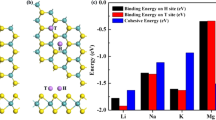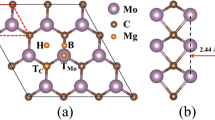Abstract
Context
We study some of the most high performance electrode materials for lithium-ion batteries. These comprise molybdenum dichalcogenide MoX2 (molybdenum disulfide MoS2, molybdenum diselenide MoSe2, molybdenum ditelluride MoTe2). The stability is studied by calculating cohesive energy and formation energy. Structural, electronic, and electrical properties are well defined, and these structures show a direct gap. Lithium adsorption at different sites, theoretical storage capacity, and lithium diffusion path are determined. Our study findings suggest that the adsorption of Li on the preferred site on the surface of the MoX2 monolayer maintains its semiconductor behavior. Comparing the activation energy barrier of these structures with other monolayers such as graphene or silicene, we found that MoX2 shows low lithium diffusion energy and good storage capacity, which indicates that the MoX2 is well suited as an anode material for lithium-ion batteries. Our research can offer new ideas for experimental and theoretical design and new anode materials for lithium-ion batteries (LIB).
Methods
The studies were performed with Quantum ESPRESSO package based on density functional theory (DFT), plane waves, and pseudopotentials (PWSCF) to calculate the physical properties of MoX2 (X = S, Se, Te), lithium adsorption, and diffusion on their surfaces and the storage capacity of these structures. The BoltzTraP code is used to calculate thermoelectric properties.







Similar content being viewed by others
Data availability
This article does not contain any supporting information as most of the important data are already provided in the manuscript.
References
He Q, Yu B, Li Z, Zhao Y (2019). Energy Environ Mater 2:264–279
Kumar MR, Singh S (2023). J Mol Model 29:193
Rahimi R, Solimannejad M (2020). J Mol Model 26:157. https://doi.org/10.1007/s00894-020-04418-0
Bhuvaneswari R, Nagarajan V, Chandiramouli R (2019). Mater Res Express 6:035504
Belasfar K, El Kenz A, Benyoussef A (2021). Mater Chem Phys 257:123751
Kulova T, Gryzlov D, Skundin A, Gavrilin I, Kudryashova Y, Pokryshkin N (2021). Int J Electrochem Sci 16:211229
Wang QH, Kalantar-Zadeh K, Kis A, Coleman JN, Strano MS (2012). Nat Nanotechnol 7(11):699
Ersan F, Ozaydin HD, Gddotokoglu G, Aktddoturk E (2017). Appl Surf Sci 425:301–306
Ruppert C, Burak AO, Heinz TF (2014). Nano Lett 14(11):6231–6236
Goodenough JB, Kim Y (2010). Chem Mater 22(3):587–603
Cheng C, Zhou G, Du J, Zhang H, Guo D, Li Q, Wei W, Chen L (2014). New J Chem 38:2250
Ataca C (2012) ahin H Ş, and CiraciStable S. J Phys Chem C 116:8983–8999
Khuili M, El Hallani G, Fazouan N, Atmani EH, Allaoui I, Al-Qaisi S, Abba EH, Lekouch K (2023). Int J Mod Phys B 37:2350210
Khuili M, Bounbaa M, Fazouan N, Elmakarim HA, Sadiki Y, Al-Qaisi S, Allaoui I, Maskar EH, Chahid EH, Maher K, Abba EH (2023). J Solid State Chem 322:123955
Khuili M, Fazouan N, Makarim HAE, Atmani EH, Abbassi A, Rai DP (2020). Superlattice Microst 145:106645
F Xiaozhen, , Xing L, Zhenglin H et al. J Mol Model 28, 225 (2022).
Nagarajan V, Ramesh R, Chandiramouli R (2023) Comput. Theor Chem 121:108449
Bhuvaneswari R, Nagarajan V, Chandiramouli R (2019). Phys B Condens Matter 562:75–81. https://doi.org/10.1016/j.physb.2019.03.022
Sharma NK, Kapila A, Vivek V, Sharma H (2022). Mater Today Sustain 20:100248
Reyes-Retana JA, Cervantes-Sodi F (2016). Sci Rep 6:24093
Hu T, Li R, Dong J (2013). J Chem Phys 139:174702
Wypych F, Schöllhorn R (1992). J Chem Soc Chem Commun 19:1386–1388
Nagarajan V, Ramesh R, Chandiramouli R (2023). J Mol Model 29:309. https://doi.org/10.1007/s00894-023-05711-4
Perdew JP, Ruzsinszky A, Csonka GI, Vydrov OA, Scuseria GE, Constantin LA, Zhou X, Burke K (2008). Phys Rev Lett 100:136406
Giannozzi P et al (2009). J Phys Condens Matter 21(39):395502
Madsen GKH, Singh DJ (2006). Comput Phys Commun 175:67–71
Ye C, Liu M (2022). J Mol Model 28:40
Fedorov V E, Mirzaeva I V, Kozlova S G, Grayfer E D, Medvedev M V, Conference: MIPRO, 2012 Proceedings of the 35th International Convention
Ding Y, Wang Y, Ni J, Shi L, Shi S, Tang W (2011). Physica B 406:2254–2260
Lahourpour F, Boochani A, Parhizgar SS, Elahi SM (2019). J Theor Appl Phys 13:191–201
Tang W, Sanville E, Henkelman G (2009). J Phys Condens Matter 21:084204
Belasfar K, Houmad M, Boujnah M, Benyoussef A, EL Kenz A (2020). J Phys Chem Solids 139:109319
Jing Y, Zhou Z, Cabrera CR, Chen Z (2013). J Phys Chem C 117(48):25409–25413
Zhao S, Kang W, Xue J (2014). J Mater Chem 2(44):19046–19052
Er D, Li J, Naguib M, Gogotsi Y, Shenoy VB (2014). ACS Appl Mater Interfaces 6(14):11173–11179
Author information
Authors and Affiliations
Contributions
(MB, MK, NF) were participated in investigations and (EHA, AI, MH) in supervising. Each of the authors has made contributions and has reached a consensus on the final version of the manuscript for publication.
Corresponding author
Ethics declarations
Ethics approval
Not applicable.
Competing interests
The authors have no competing interests to declare that are relevant to the content of this article
Additional information
Publisher’s Note
Springer Nature remains neutral with regard to jurisdictional claims in published maps and institutional affiliations.
Rights and permissions
Springer Nature or its licensor (e.g. a society or other partner) holds exclusive rights to this article under a publishing agreement with the author(s) or other rightsholder(s); author self-archiving of the accepted manuscript version of this article is solely governed by the terms of such publishing agreement and applicable law.
About this article
Cite this article
Bounbaâ, M., Khuili, M., Fazouan, N. et al. Li adsorption and diffusion on the surfaces of molybdenum dichalcogenides MoX2 (X = S, Se, Te) monolayers for lithium-ion batteries application: a DFT study. J Mol Model 29, 378 (2023). https://doi.org/10.1007/s00894-023-05787-y
Received:
Accepted:
Published:
DOI: https://doi.org/10.1007/s00894-023-05787-y




